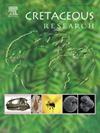美国科罗拉多州达科他砂岩(dinosaur Ridge, Colorado, USA)中一新的兽脚亚目恐龙化石
IF 1.9
3区 地球科学
Q1 GEOLOGY
引用次数: 0
摘要
无人机拍摄的高分辨率航空图像记录了美国科罗拉多州恐龙岭上白垩纪(Cenomanian)达科他砂岩的两个地层水平上新的非鸟类兽脚亚目兽脚亚目交配展示痕(Ostendichnus)。我们描述并识别它们的形态、方向和包括套印在内的聚类模式。另外25个刮痕记录在2个地层面上(24个在2b面,俗称“恐龙求偶”面;一个在2h面上。2b表面上的额外刮痕将其地位提升为化石鸟巢展示场所或lek。大多数刮痕具有诊断性的“双叶状”形状,但也有一些是碗状的,与ostendichnus类痕迹的描述一致,并且在除一个结构外的所有结构中都含有可检测到的趾爪痕迹。本文提出了一种新的方法来确定痕迹制造者在制造刮痕时所面对的方向(方位角),这种方法适用于没有脚印的Ostendichnus,爪痕的前部发散,凹槽的后部逐渐变细,以及痕迹后部出土的沙新月形沉积物堆。对恐龙岭遗址和科罗拉多西部已知的三个遗址——俱乐部峡谷(n = 2)和鲁比多溪——的分析,可以通过与现代鸟类类似物的比较,深入了解兽脚亚目恐龙的社会行为,特别是那些留下痕迹的兽脚亚目恐龙,筑巢,筑巢和展示活动的结合,筑巢包括挖掘,在某些情况下,利用现有材料重新配置。本文章由计算机程序翻译,如有差异,请以英文原文为准。
A new theropod dinosaur lek in the Cretaceous Dakota Sandstone (Dinosaur Ridge, Colorado, USA)
High-resolution aerial imagery captured by drones document new non-avian theropod mating display scrapes (Ostendichnus) along two stratigraphic levels of the Upper Cretaceous (Cenomanian) Dakota Sandstone at Dinosaur Ridge, Colorado, USA. We describe and identify their morphologies, orientations, and patterns of clustering that include overprinting. Twenty-five additional scrapes are documented on 2 stratigraphic surfaces (24 on surface 2b, colloquially the “Dinosaur Courtship” surface; and 1 on surface 2h). The additional scrapes on surface 2b elevates its status to a fossilized nest display arena or lek. Most of the scrapes have the diagnostic “bilobate” shape, but some are bowl-shaped consistent with the description of Ostendichnus-like traces and contain well-detectable toe claw marks in all but one of the structures. A new means to determine the direction the trace maker faced while creating the scrapes (azimuth) is proposed for Ostendichnus lacking footprints, anterior divergence of claw marks, posterior tapering of troughs, and a sand crescent pile of excavated sediment at the posterior of the trace. Analysis of the Dinosaur Ridge sites and of 3 previously known lek sites in western Colorado—Club Gulch (n = 2) and Roubideau Creek— permit insight into the social behavior of the trace making theropods by comparisons to modern avian analogs, particularly those of lekking, nest scrape display, a combined nest building and display activity, and nest building that involves digging, and― in some cases― reconfiguration using available materials.
求助全文
通过发布文献求助,成功后即可免费获取论文全文。
去求助
来源期刊

Cretaceous Research
地学-地质学
CiteScore
4.10
自引率
19.00%
发文量
235
审稿时长
12 weeks
期刊介绍:
Cretaceous Research provides a forum for the rapid publication of research on all aspects of the Cretaceous Period, including its boundaries with the Jurassic and Palaeogene. Authoritative papers reporting detailed investigations of Cretaceous stratigraphy and palaeontology, studies of regional geology, and reviews of recently published books are complemented by short communications of significant new findings.
Papers submitted to Cretaceous Research should place the research in a broad context, with emphasis placed towards our better understanding of the Cretaceous, that are therefore of interest to the diverse, international readership of the journal. Full length papers that focus solely on a local theme or area will not be accepted for publication; authors of short communications are encouraged to discuss how their findings are of relevance to the Cretaceous on a broad scale.
Research Areas include:
• Regional geology
• Stratigraphy and palaeontology
• Palaeobiology
• Palaeobiogeography
• Palaeoceanography
• Palaeoclimatology
• Evolutionary Palaeoecology
• Geochronology
• Global events.
 求助内容:
求助内容: 应助结果提醒方式:
应助结果提醒方式:


